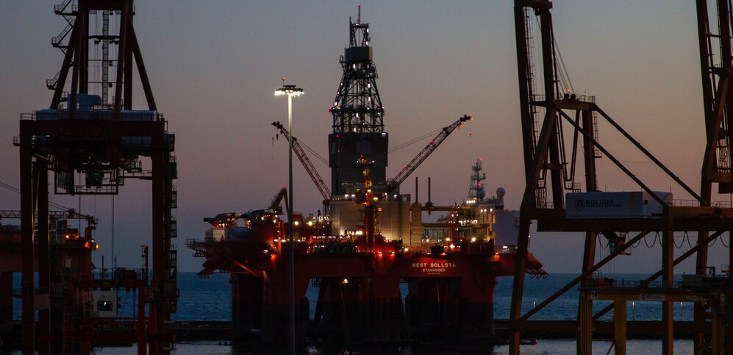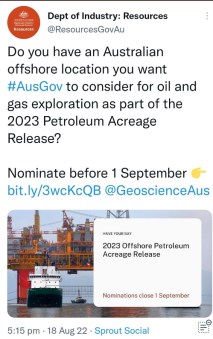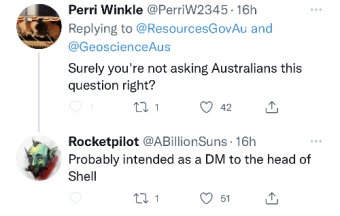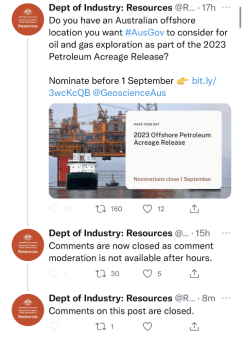
Source: Maria Lupan/Unsplash
Working at a brand and culture studio, things can sometimes get a bit lofty and theoretical. So it’s interesting to see your theories proven out in real time.
On Thursday evening, the Federal Department of Industry: Resources rolled out this tweet on its @ResourcesGovAu handle:

Source: supplied.
Within minutes, there were a slew of responses like this:

Source: supplied.
Funny, angry, snarky comments by people with large followings. Within two hours, the post was locked for comments, and on Friday morning comments were disabled completely.

Source: supplied.
I spent years running social media teams and formulating content strategies for brands like Mars, CUB, Telstra and more recently, KeepCup, MAAP and Intrepid. So I still break out in a cold sweat when I see a completely avoidable social or PR disaster rolling out in real time.
Fundamentally, what’s consistent across all social media and PR disasters is a blindness to the culture that our brand or organisation is lobbing communications pebbles into. This means you can’t anticipate the ripples it will cause.
To state the obvious: offshore gas and oil exploration is a divisive and contentious issue. So contentious that the then-prime minister took on secret powers in order to veto a project ahead of the 2022 election — story that was swirling around in the culture just as the social media manager was hitting the button. And that’s before we even go into the climate crisis that we’re experiencing.
At SouthSouthWest, we formulate and assess our work on a framework of ‘culture, thinking and design’. It’s a simple framework that we use as a way of selecting opportunities, seeking out collaborators and creating brands. In a practical project scenario, we start by mapping out the key ‘thinking’, ‘cultural references’ and ‘design ideas’ for any given project. This helps us to arrange our ideas and start to look at how we can join the dots.
When we find a simple organising idea that sits in the middle of all three, we know we are onto something. If any of the three elements aren’t covered off in the idea we’re shaping, we know it won’t work so we don’t waste any time pushing ahead until the disconnect is resolved.
A great business idea or strategy that’s poorly designed or doesn’t pull on a cultural thread won’t fly. When all three are in balance, you can create an authentic brand or moment that’s going to create real human impact. And that’s how you ensure that your brand always bubbles to the surface.
All three of those principles can be looked at as equal, but you ignore culture at your peril.
Look up and think deeply about where your brand fits in the sea of noise that surrounds us. Then take your partners on that journey, so that everyone shares a sense of belonging. If you don’t think deeply about it, things can go off the deep end quickly.
Which brings us back to offshore drilling.
What could the team have done differently? It doesn’t have to be much. Take the appropriate steps to understand the culture your communications will land in. Read the hashtags. Do some research. Run some focus groups. Do a bit of a risk/reward analysis on your comms. How many genuine responses should the department have expected on Twitter? And how many furious, funny and snarky responses should they have expected?
Run your communications through a cultural lens, and you might just avoid the next offshore drilling disaster.
Ben Birchall is the director of brand voice at SouthSouthWest. This article was first published on LinkedIn.
Handpicked for you

Allergy-friendly spread business Buddee lands $1 million deals with Coles and Woolworths



COMMENTS
SmartCompany is committed to hosting lively discussions. Help us keep the conversation useful, interesting and welcoming. We aim to publish comments quickly in the interest of promoting robust conversation, but we’re a small team and we deploy filters to protect against legal risk. Occasionally your comment may be held up while it is being reviewed, but we’re working as fast as we can to keep the conversation rolling.
The SmartCompany comment section is members-only content. Please subscribe to leave a comment.
The SmartCompany comment section is members-only content. Please login to leave a comment.